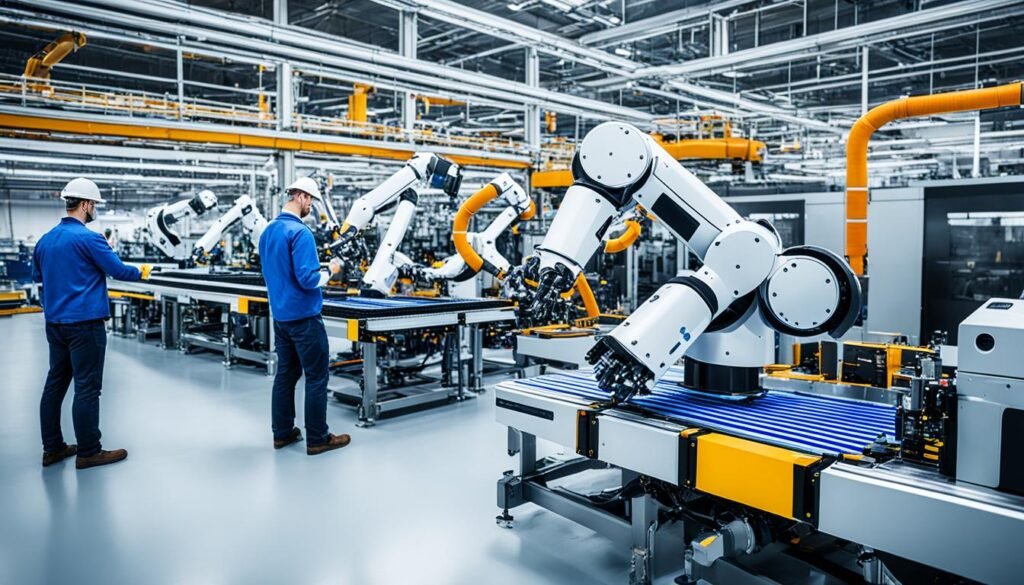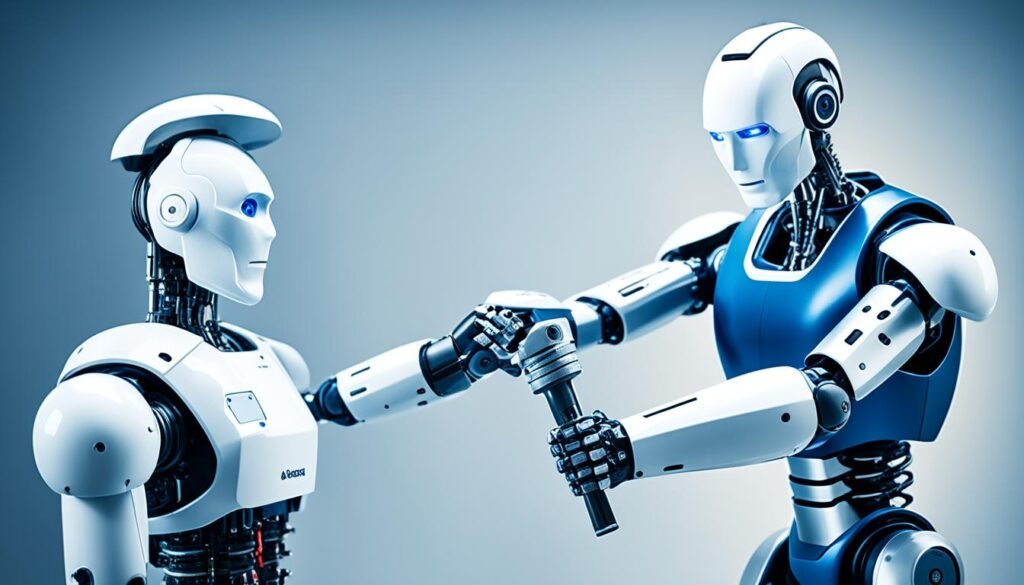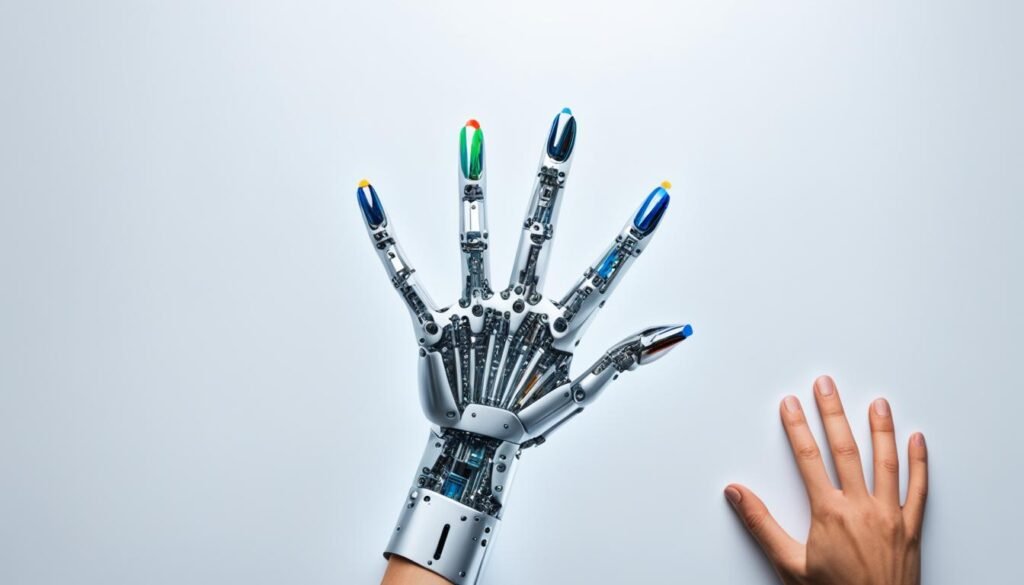Many think AI will soon replace human workers. But, the World Economic Forum says AI will create about 97 million new jobs by 2025, while replacing 85 million old ones. This shows AI has its limits and humans still bring great value to work.
AI has improved at doing some tasks, but it can’t beat humans in emotional smarts, creativity, and adapting to new things. These skills make humans key in the workplace, even as AI gets better.
This article will show you why humans have a big advantage at work. We’re great at making connections, solving problems, and coming up with new ideas. These skills give us a unique edge that AI can’t match, keeping us important in the future workforce.
Key Takeaways
- AI lacks the emotional intelligence needed for team management, teaching, and counseling.
- Humans are better at soft skills like negotiation, being adaptable, and being creative, which are key in many jobs.
- AI struggles with new situations because it’s only as good as the data it gets.
- Creativity, which is vital for innovation, is hard for AI because it can only use data it has, not make new ideas.
- Humans are still needed for checking facts, overseeing things, and training AI, showing how crucial we are in making things work.
What Are Artificial Intelligence and Automation?
Artificial intelligence (AI) is a fast-growing field that aims to make machines do tasks that usually need human smarts, like learning and solving problems. AI systems can automate many tasks and find insights in big data, changing how we work and live. Automation technology, on the other hand, makes processes and tasks run smoother with less human help, boosting efficiency and productivity.
Defining AI and Automation Technologies
AI includes many technologies like machine learning, natural language processing, and computer vision. These let machines understand and make sense of data, decide, and even be creative. Automation uses technology to do tasks that need to be done over and over, faster and more accurately than people.
Capabilities and Limitations
AI and automation can do many things faster and more accurately than humans, but they’re not perfect. AI’s limits come from the data it gets and its struggle with completely new situations. Automation is great at doing the same task over and over, but it’s not for everything. Both are meant to help humans, not replace them.
| Metric | AI Capabilities | Automation Capabilities |
|---|---|---|
| Task Complexity | Can handle complex tasks | Great at repetitive tasks |
| Adaptability | Learns and adapts, but still has limits | Sticks to specific tasks |
| Decision-Making | Makes decisions based on data | Follows set rules |
| Job Displacement | Could affect many jobs | Mostly impacts jobs with repetitive tasks |
In summary, artificial intelligence and automation technology are big tools that can make us work better, faster, and smarter. But they’re not perfect and are meant to work with humans, not replace them. The growth of robotic process automation, machine learning, and natural language processing means big changes for the future of work. We need to find a balance that values what humans and machines do best.

AI Has No Physical Form
Artificial intelligence (AI) and automation have made big strides, but they can’t match human physical skills. AI systems and robots don’t have a body and work mainly in the digital world. They can’t do tasks that need hand-eye coordination or complex physical work. These tasks are best done by humans.
Robots vs. Software AI
Robots can help with tasks like moving boxes or doing repetitive work in a controlled space. But they can’t replace humans in situations that need creative problem-solving. Software AI is mainly for digital tasks and can’t handle many real-world tasks.
Tasks Requiring Physical Intervention
- Manual labor and complex physical tasks
- Situations that require quick adaptation and decision-making
- Creative problem-solving that involves physical elements
Tasks that need both physical and mental skills are still best for humans. AI and automation can help in some areas, but they can’t replace human skills fully.

“AI systems may excel at specific digital tasks, but they still fall short when it comes to the physical world and the full range of human abilities.”
AI Lacks Emotional Intelligence
Technology is getting better, and AI is more impressive every day. But, AI can’t match human emotional intelligence (EQ). EQ helps us understand and meet others’ emotional needs. AI doesn’t have this skill yet.
Humans learn EQ from years of social life. This lets us connect deeply with others. AI, on the other hand, focuses on thinking skills, not feelings. It can pretend to feel emotions but doesn’t truly experience them like we do.
This means AI can’t fully interact with us emotionally, which is a big deal in many areas. In customer service, EQ builds trust and helps solve problems. In healthcare, it lets doctors connect with patients and care more deeply.
“Emotional intelligence is a crucial factor in fields like healthcare, education, entertainment, and security, where human connection and understanding are paramount.”
As AI gets better, we need to see its limits in EQ. AI is great for analyzing data and making decisions. But, it can’t replace our empathy, social skills, or emotional bonds. The future will likely be about working together, using AI’s strengths and our EQ.

In summary, AI’s lack of EQ is a big thing to remember. As we use AI more in our lives, we must know what it can and can’t do. We should keep human values and EQ at the heart of tech progress.
AI Can’t Match Human Creativity
AI has made big strides in fields like healthcare, finance, and manufacturing. But, it still can’t beat human creativity. Creativity is a special human skill that comes from our experiences, intuition, and thinking differently. AI, with its limited data, struggles to copy this.
Creativity as a Human Advantage
Being creative often means feeling and thinking in ways AI can’t. Humans add their own feelings and experiences to their work. This makes their creations special and unique. Whether it’s writing, music, or art, the human touch is something AI can’t match.
AI as a Creative Tool, Not a Replacement
AI can help in creative tasks but isn’t a substitute for human creativity. Tools like GANs and OpenAI’s DALL-E can make art and write stories. But, they’re limited by their training and lack human creativity’s spark.
AI can enhance creativity, but it can’t replace the unique spark of human innovation.
| Metric | Human Creativity | AI Creativity |
|---|---|---|
| Emotional Intelligence | High | Low |
| Contextual Understanding | Comprehensive | Limited |
| Originality | Highly innovative | Constrained by training data |
| Spontaneity | Fluid and adaptive | Rigid and predetermined |

As AI gets better, it will play a bigger role in creative fields. But, human creativity’s unique qualities like emotional smarts and spontaneity are still unmatched. Using AI as a tool, not a replacement, lets us find new ways to innovate and solve problems with both human and AI skills.
why ai can’t replace humans
AI is getting better, but it won’t replace human workers anytime soon. AI can’t fully match human skills because it has big limits. It needs humans to work well.
AI is Limited by Input Data
AI’s biggest problem is its data limits. It can only do as well as the data it gets. It can’t think or adapt like humans do. This makes AI prone to data biases and mistakes.
Human Oversight is Still Required
Even with AI’s growth, human oversight is key. Many tasks need human judgment and the ability to change plans. Theo Omtzigt, CTO at Lemurian Labs, says, “AI can spot house cats but can’t solve big problems like world hunger.” AI accountability means humans will always be needed to check AI’s work.
AI can help make things more efficient, but it can’t replace human smarts. The best future is when humans and AI work together. They can use each other’s strengths for more innovation and success.
“AI can recognize objects like house cats, but it lacks the ability to tackle complex issues such as world hunger.”
– Theo Omtzigt, CTO at Lemurian Labs
AI Lacks Soft Skills
The workforce is changing fast, making soft skills like communication, empathy, and teamwork more important. These skills are key for doing well in today’s jobs. But, artificial intelligence (AI) can’t match the emotional and social skills we humans have. AI is great at doing specific tasks quickly, but it can’t understand human feelings or work well with people.
Importance of Soft Skills in the Workplace
Soft skills help us read people’s feelings, negotiate, and work together towards goals. They make the workplace better and help us get along with our coworkers and clients. These skills come from being around people and learning from our experiences. AI can’t learn these skills because it doesn’t have the same kind of life experiences as humans. Employers now see the value in soft skills because they help with teamwork, solving problems, and doing a good job.
Human Abilities AI Cannot Replicate
- Empathy and emotional intelligence: AI can’t really understand or react to human feelings and experiences.
- Adaptability and problem-solving: Humans are great at adjusting to new situations and coming up with creative solutions. AI finds it hard with unclear situations.
- Leadership and vision: Leading and guiding others needs a personal touch that AI doesn’t have.
- Collaboration and teamwork: Humans work well together, supporting and encouraging each other. AI can’t do this.
The job market is always changing, making the human touch more valuable. AI is a powerful tool at work, but it can’t replace the soft skills that make humans so important today.
| Soft Skill | Description | Importance in the Workplace |
|---|---|---|
| Communication | Getting ideas across, listening well, and changing how you talk to different people. | Key for working together, building good relationships, and sharing information clearly. |
| Teamwork | Working well with others, helping the team, and solving problems together. | Makes work better, creates a positive place to work, and leads to better results. |
| Adaptability | Being able to change and learn from new things, and always be ready for challenges. | Helps people do well in a changing job market and makes the company more flexible. |
| Problem-Solving | Thinking deeply, being creative, and finding and using good solutions. | Helps companies deal with tough problems and find new chances. |
| Leadership | Leading, motivating, and guiding others to reach common goals. | Very important for bringing new ideas, building a team that works together, and reaching business goals. |
“The future of work demands a new set of human-centric skills that AI cannot replicate. Soft skills like empathy, creativity, and adaptability will become increasingly valuable as we navigate the ever-evolving technological landscape.”
AI Still Needs Fact-Checking
AI has made big steps in handling lots of data and making responses sound natural. But, it still can’t think deeply or understand the truth like humans do. This means AI can spread wrong info and miss key details. So, we need humans to check facts and verify information.
Professor Shannon Vallor says AI should help us, not take our place. She studies how new tech affects our character and habits. She also helps guide policymakers and the tech industry on using AI ethically.
Misinformation and Lack of Nuance
Using AI alone can lead to spreading false or biased info. This is a big problem in areas like news, health, and making decisions. AI tools aren’t good at helping journalists or making quick decisions because they miss the deeper understanding needed to check facts.
Human Verification is Essential
As AI gets better, we’ll still need humans to check its work. In places like the Middle East and North Africa, people do more fact-checking than in the USA or Europe. This shows how important it is to have humans check AI’s work to fix its limitations.
“Algorithmic fact checking will become more common in 2023, but AI’s accuracy is only measured to the hundredth of a percent against certain datasets.”
AI can help spot false info, but it has its limits. We still need humans to make sure AI is used right and with expert advice. This way, we can keep info trustworthy and avoid the downsides of AI limitations and bias.
Automation Needs Humans
Many think AI and automation will replace humans, but that’s not true. These technologies are meant to work with humans, not replace them. Automation systems, like robotic process automation (RPA), need humans to make them work right. Humans train, keep up, and fix these automated processes when needed.
Creating and using AI-powered automation takes a lot of human work. From getting the data ready to designing and testing algorithms, humans are key. Without us, these systems wouldn’t work. So, the future will be about working together, with humans and machines doing what they do best.
Human-in-the-Loop Systems
Automation isn’t a one-way street; it needs humans to make it work. In “human-in-the-loop” systems, people watch over, tweak, and fix automated processes. This teamwork makes sure automation stays on track, doing its job well.
Training and Maintaining Automation
How well automation and AI work depends a lot on the data they use. Humans are key in getting the data ready and checking it’s right. They also keep the systems running smoothly by updating them.
As automation and AI get better, we’ll need to work with them more. By using our skills to solve problems and innovate, we’ll make automation even better. This teamwork will make us all more effective.
“AI is still in its early stages and will get much better in the next five to ten years. Humans will keep facing new challenges, showing why we’re so important in finding solutions and helping each other.”
Conclusion
The future of work will be a team effort between humans and machines. Each will add their own strengths to the mix. AI and automation are getting better, but they can’t replace human workers. They lack physical form, emotional smarts, and creative problem-solving skills. These are key skills that make humans stand out at work.
Humans also have soft skills like good communication and teamwork that AI can’t match. AI needs humans to check its work to make sure it’s right and reliable. This shows we still need humans in the picture.
Jobs like translators, ad copywriters, graphic designers, and programmers might face AI threats. But, companies should focus on training their workers and finding the right mix of human and machine skills. This means using AI to boost human skills, keeping human oversight, and setting rules for when humans should step in.
By recognizing AI’s limits and valuing human skills, companies can thrive in the changing job market. This means investing in training and setting ethical AI guidelines. The future will bring big changes, but by working together, humans and AI can open new doors and build a better, more inclusive work world.
FAQ
Why can’t AI replace humans in the workplace?
AI can’t replace humans because it lacks physical form, emotional smarts, and creative problem-solving skills. Humans have special cognitive abilities and soft skills that AI can’t match. AI is meant to work with human intelligence, not against it.
What are the key differences between AI and automation technologies?
AI aims to make machines that can do tasks that need human smarts, like learning and solving problems. Automation makes processes smoother with little human help, making things more efficient. Both help humans, but they don’t aim to replace us.
How is AI limited by its lack of physical form?
AI has no body, unlike humans. So, tasks that need hand-eye coordination or physical work are best for humans. Robots can help with some tasks, but they’re not yet good enough for complex situations.
Why does AI lack emotional intelligence?
Emotional smarts are key to human interactions and decisions, but AI doesn’t have them. Humans learn to understand and meet others’ emotional needs through life and social interactions. AI focuses on thinking skills, not feelings.
Can AI match human creativity?
Creativity is a human thing that AI finds hard to copy. AI can help with creative tasks, but it can’t truly innovate or think outside the box. Human creativity is unique and will always be valuable, with AI as a tool to help.
How are AI systems limited by the input data they receive?
AI’s limits come from the data it’s trained on. It can only go as far as the info and algorithms it gets. This means AI can be biased or wrong if the data is, and it needs humans to check its work.
What are the soft skills that give humans an advantage over AI?
Soft skills like communication, teamwork, empathy, and flexibility are key in the workplace. These skills come from human experience and social life. As jobs change, the need for these human skills will grow, making AI less of a threat.
Why is human verification and fact-checking essential for AI outputs?
AI can make mistakes or spread false info because it doesn’t think like humans do. It can process lots of data but misses human judgment and common sense. Relying only on AI can lead to spreading wrong information, which is bad.
How do humans and machines collaborate in the future of work?
AI and automation won’t replace humans; they’re meant to help and improve what humans do. Systems like RPA need humans to work right. The future will be about working together, with humans and machines using their strengths.
